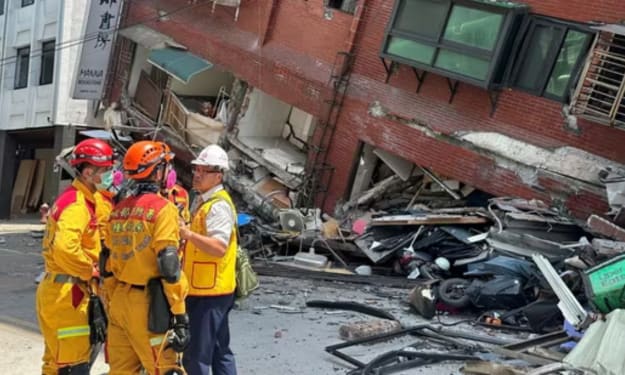
Introduction:
The seismic tremors that reverberated through Taiwan on Wednesday, marked by a staggering 7.2 magnitude on the Richter scale, sent shockwaves of concern across the region. This cataclysmic event, touted as the most potent earthquake to strike the island in over a quarter-century, has brought forth a myriad of consequences, both in terms of human casualties and environmental upheaval. As rescue operations scramble to address the aftermath, it becomes imperative to delve deeper into the intricacies of this seismic occurrence and its repercussions on the affected communities.
The Impact of the Earthquake:
The seismic upheaval struck with unprecedented force, claiming at least one life and inflicting injuries upon over 50 individuals. The epicenter, nestled near the Hualien region, a topography characterized by rugged mountains and sparse population, magnified the tremors' intensity. Taiwan's Central Weather Administration reported a seismic depth of 15.5 km, underscoring the profound magnitude of the geological event. Concurrently, Japan's meteorological agency documented the arrival of minor tsunami waves along certain coastal areas of southern Okinawa, further exacerbating the crisis.
Tsunami Warnings and Advisory:
In the wake of the earthquake's onslaught, tsunami warnings were promptly issued for swathes of Japan and the Philippines, amplifying the sense of urgency and trepidation among coastal communities. However, as subsequent reports emerged, these warnings underwent a transition to advisories, signifying a slight reprieve from the immediate threat. The Pacific Tsunami Warning Center in Hawaii echoed this sentiment, affirming the gradual diminishment of significant tsunami waves, albeit residual caution lingered.
Mitigation Efforts and Response Mechanisms:
The seismic tremors precipitated a swift mobilization of emergency response teams and disaster management protocols, poised to mitigate the burgeoning humanitarian crisis. In the Philippines, the Seismology Agency issued directives urging residents in coastal provinces to seek refuge in higher ground, preempting potential tsunami repercussions. Similarly, Taiwan's proactive measures, including the issuance of tsunami warnings, underscored a concerted effort to safeguard vulnerable communities from the calamitous aftermath.
Environmental and Infrastructural Ramifications:
Beyond the immediate human toll, the earthquake's reverberations have wrought havoc on the environmental landscape and vital infrastructural assets. Landslides, triggered by seismic activity, have posed formidable challenges to accessibility and relief operations, particularly in remote mountainous regions. Moreover, disruptions to critical utilities, including power and communication networks, have further compounded the logistical hurdles faced by rescue teams, necessitating a multifaceted approach to restoration efforts.
Community Resilience and Solidarity:
Amidst the chaos and devastation, tales of resilience and solidarity emerge as beacons of hope amidst the darkness. Communities, galvanized by a shared sense of adversity, have rallied together to extend support and aid to those grappling with the aftermath of the earthquake. Acts of altruism and compassion serve as poignant reminders of the indomitable human spirit, resilient in the face of nature's wrath.
Conclusion:
As the dust settles and the tremors subside, the indelible scars of the 7.2 magnitude earthquake serve as sobering reminders of the fragility of human existence in the face of geological forces. Yet, amidst the wreckage and despair, seeds of resilience and unity take root, nurturing a collective resolve to rebuild and recuperate. Moving forward, it is incumbent upon us to heed the lessons imparted by this seismic upheaval, fostering a culture of preparedness and solidarity to confront the uncertainties of tomorrow.
Frequently Asked Questions (FAQs) about the Taiwan Earthquake
What caused the earthquake in Taiwan?
The earthquake in Taiwan was caused by the shifting of tectonic plates beneath the Earth's surface, resulting in seismic tremors.
How strong was the earthquake in Taiwan?
The earthquake in Taiwan measured a magnitude of 7.2 on the Richter scale, making it one of the most powerful quakes to hit the island in over 25 years.
Was there any loss of life or injuries reported?
Yes, at least one person was reported dead, and over 50 individuals sustained injuries as a result of the earthquake.
Did the earthquake trigger any tsunamis?
Yes, the earthquake led to tsunami warnings for parts of Japan and the Philippines. Minor tsunami waves were observed in certain coastal areas of southern Okinawa, Japan.
What actions were taken in response to the tsunami warnings?
Emergency response agencies promptly issued warnings and advisories, urging residents in coastal areas to move to higher ground as a precautionary measure. Tsunami warnings were later downgraded to advisories as the threat diminished.
How did the earthquake impact infrastructure and the environment?
The earthquake caused landslides and disruptions to critical infrastructure such as power and communication networks. These effects posed challenges to relief efforts and accessibility in affected areas.
How are communities coping with the aftermath of the earthquake?
Communities affected by the earthquake have demonstrated resilience and solidarity, coming together to support those in need. Acts of altruism and compassion have been observed, highlighting the strength of community bonds in times of adversity.
What lessons can be learned from this earthquake?
The earthquake underscores the importance of preparedness and disaster response measures. It serves as a reminder of the need for resilient infrastructure and proactive mitigation strategies to minimize the impact of future seismic events.
About the Creator
Reader insights
Nice work
Very well written. Keep up the good work!
Top insight
Easy to read and follow
Well-structured & engaging content





Comments
There are no comments for this story
Be the first to respond and start the conversation.